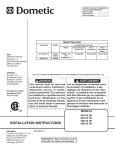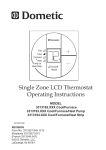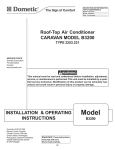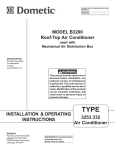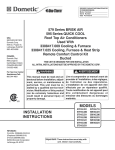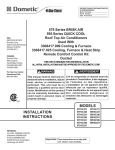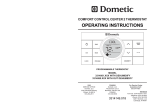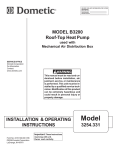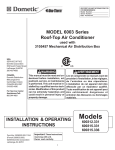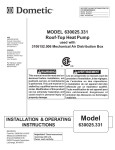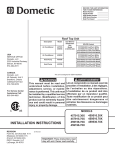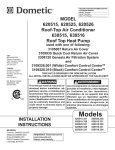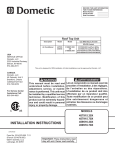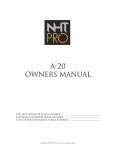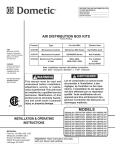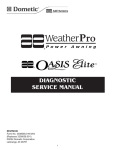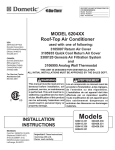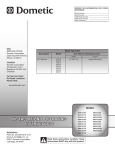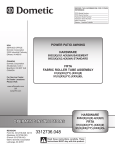Download Dometic 641516.306 Specifications
Transcript
641515, 641516, 641535, 651515 & 651516 Installation Instructions RECORD THIS UNIT INFORMATION FOR FUTURE REFERENCE: Model Number Serial Number Date Purchased MODEL 641515, 641516, 641535 Roof Top Air Conditioners 651515, 651516 Roof-Top Heat Pump used with 3106615 Air Distribution Box 3109228 Comfort Control CenterTM USA SERVICE OFFICE Dometic, LLC 2320 Industrial Parkway Elkhart, IN 46516 574-294-2511 This Unit Is Designed For OEM Installation. All Initial Installations Must Be Approved By Dometic, LLC CANADA Dometic, LLC 46 Zatonski, Unit 3 Brantford, ON N3T 5L8 CANADA 519-720-9578 For Service Center Assistance Call: 800-544-4881 This manual must be read and understood before installation, adjustment, service, or maintenance is performed. This unit must be installed by a qualified service technician. Modification of this product can be extremely hazardous and could result in personal injury or property damage. Lire et comprendre ce manuel avant de procéder à l'installation, à des réglages, de l'entretien ou des réparations. L'installation de cet appareil doit être effectuée par un réparateur qualifié. Toute modification de cet appareil peut être extrêmement dangereuse et entraîner des blessures ou dommages matériels. MODELS INSTALLATION INSTRUCTIONS 641515.301 641515.306 641516.301 641516.306 3312127.000 Form No. 3312127.000 10/08 (French 3312128.000) ©2008 Dometic, LLC LaGrange, IN 46761 Important: These Instructions must stay with unit. Owner read carefully. 1 641516.331 641535.301 641535.306 651515.301 651515.306 651516.301 651516.306 651516.331 641515, 641516, 641535, 651515 & 651516 Installation Instructions SAFETY INSTRUCTIONS GENERAL INFORMATION A. Product features or specifications as described or il- This manual has safety information and instructions to help users eliminate or reduce the risk of accidents and injuries. B. RECOGNIZE SAFETY INFORMATION C. This is the safety-alert symbol. When you see this symbol in this manual, be alert to the potential for personal injury. Follow recommended precautions and safe operating instructions. UNDERSTAND SIGNAL WORDS A signal word, WARNING OR CAUTION is used with the safety-alert symbol. They give the level of risk for potential injury. indicates a potentially hazardous situation which, if not avoided, could result in death or serious injury. indicates a potentially hazardous situation which, if not avoided may result in minor or moderate injury. lustrated are subject to change without notice. This "Air Conditionr" /"Heat Pump" (hereinafter referred to as the "unit") Is Designed For: 1. Installation on a recreational vehicle during the time the vehicle is manufactured. 2. Mounting on the roof of a recreational vehicle. 3. Roof construction with rafters/joists on minimum of 16 inch centers. 4. Minimum of 2.00 inches and maximum of 4.00 inches distance between roof to ceiling of recreational vehicle. Alternate installation methods will allow for roofs more than 4.00 inches thick. The ability of the unit to maintain the desired inside temperature depends on the heat gain of the RV. Some preventative measures taken by the occupants of the RV can reduce the heat gain and improve the performance of the unit. During extremely high outdoor temperatures, the heat gain of the vehicle may be reduced by: 1. Parking the RV in a shaded area; 2. Using window shades (blinds and/or curtains); 3. Keeping windows and doors shut or minimizing usage; 4. Avoiding the use of heat producing appliances. 5. Operation on High Fan/Cooling mode will give optimum or maximum efficiency in high humidity or high outside temperatures. 6. Starting the unit early in the morning and giving it a "head start" on the expected high outdoor ambient will greatly improve its ability to maintain the desired indoor temperature. 7. For a more permanent solution to high heat gain, accessories like A&E outdoor patio and window awnings will reduce heat gain by removing the direct sun. They also add a nice area to enjoy company during the cool of the evening. D. Condensation Note: The manufacturer of this unit will not be responsible for damage caused by condensed moisture on ceilings or other surfaces. Air contains moisture and this moisture tends to condense on cold surfaces. When air enters the RV, condensed moisture may appear on the ceiling, windows, metal parts, etc. The unit removes this moisture from the air during normal operation. Keeping doors and windows closed when this unit is in operation will minimize condensed moisture on cold surfaces. used without the safety alert symbol indicates, a potentially hazardous situation which, if not avoided may result in property damage. Read and follow all safety information and instructions. 2 641515, 641516, 641535, 651515 & 651516 Installation Instructions SPECIFICATIONS Model Number Nominal Capacity (BTU/HR) Cooling Electrical Rating Amps Compressor Rated Load Amps Compressor Locked Rotor Amps Fan Motor Rated Load Amps Fan Motor Locked Rotor Amps Refrigerant R-410A (Oz.) Minimum Wire Size* AC Circuit Protection *** User Supplied Installed Weight (Pounds) Minimum Generator Size** 1 Unit/2 Units 641515.301 13,500 61.0 3.5 10.0 17.5 96 3.5 KW/5.0 KW 12.5 61.0 3.5 10.0 17.5 12 AWG Copper Up To 24’ 20 Amp 13,500 120VAC 60Hz. 1 Phase 12.5 641515.306 20 Amp 97 3.5 KW/5.0 KW 6451516.301 High Capacity 12.3 61.0 3.3 8.5 23.0 20 Amp 105 3.5 KW/5.0 KW 6451516.306 High Capacity 12.3 61.0 3.3 8.5 23 20 Amp 106 3.5 KW/5.0 KW 6451516.331 15,000 13.2 66.0 3.3 8.5 22.5 20 Amp 105 3.5 KW/5.0 KW 641535.301 13,500 12.5 61.0 3.5 10.0 17.5 20 Amp 97 3.5 KW/5.0 KW 641535.306 13,500 12.5 61.0 3.5 10.0 17.5 20 Amp 98 3.5 KW/5.0 KW 651515.301 13,500 12.5 61.0 3.5 10.0 25.0 20 Amp 98 3.5 KW/5.0 KW 651515.306 13,500 12.5 61.0 3.5 10.0 25.0 20 Amp 99 3.5 KW/5.0 KW 651516.301 High Capacity 12.3 61.0 3.3 8.5 24.0 20 Amp 106 3.5 KW/5.0 KW 651516.306 High Capacity 12.3 61.0 3.3 8.5 24.0 20 Amp 107 3.5 KW/5.0 KW 651516.331 15,000 13.2 66.0 3.3 8.5 23.0 20 Amp 106 3.5 KW/5.0 KW For wire length over 24 ft., consult the National Electric Code for proper sizing. Dometic, LLC gives GENERAL guidelines for generator requirements. These guidelines come from experiences people have had in actual applications. When sizing the generator, the total power usage of your recreational vehicle must be considered. Keep in mind generators lose power at high altitudes and from lack of maintenance. *** CIRCUIT PROTECTION: Time Delay Fuse or HACR Circuit Breakers Required. * ** • It is preferred that the unit be installed on a relatively flat and level roof section measured with the RV parked on a level surface. Note: A 8° slant to either side, or front to back, is acceptable for all units. 1. For one unit installation: The unit should be mounted slightly forward of center (front to back) and centered from side to side. 2. For two unit installations: Install one Unit 1/3 and one Unit 2/3’s from front of RV and centered from side to side. 3. After Location Has Been Selected: a. Check for obstructions in the area where unit will be installed. See FIG 1. INSTALLATION INSTRUCTIONS A. Precautions Improper installation may damage equipment, could endanger life, cause serious injury and/ or property damage. 1. Read Installation and Operating Instructions carefully before attempting to start your unit installation. 2. Dometic, LLC will not be liable for any damages or injury incurred due to failure in following these instructions. 3. Installation must comply with the National Electrical Code ANSI/NFPA-70 and CSA Standard C22.1 (latest edition and any State or Local Codes or regulations. 4. DO NOT add any devices or accessories to this unit except those specifically authorized by Dometic. 5. This equipment must be serviced by qualified personnel and some states require these people to be licensed. FIG. 1 9-1/2" 40" 29" Keep these areas Free of Obstructions 14-1/4" x 14-1/4" (±1/8") Opening 12" Center Line Of Unit Front B. Choosing Proper Location For The Unit This unit is specifically designed for installation on the roof of a recreational vehicle (RV). When determining your cooling requirements, the following should be considered: • Size of RV; • Window area (increases heat gain); • Amount of insulation in walls and roof; • Geographical location where the RV will be used; • Personal comfort level required. Dimensions Are Nominal 4" 4" b. The roof must be designed to support 130 pounds when the RV is in motion. Normally a 200 lb. static load design will meet this requirement. 3 641515, 641516, 641535, 651515 & 651516 Installation Instructions c. Check inside the RV for return air kit obstructions (i.e. door openings, room dividers, curtains, ceiling fixtures, etc.) See FIG 2. c. 20" FIG. 2 22" 2-1/2" The opening created must be framed to provide adequate support and prevent air from being drawn from the roof cavity. Lumber 3/4" or more in thickness must be used. Remember to provide an entrance hole for power supplies, furnace wiring, 4-conductior control cable, remote sensor and load shed (Energy Management System) options as desired. See FIG. 3. FIG. 3 Dimensions Are Nominal Perimeter Of Air Box 2-7/8" Do Not Cut Roof Structure Or Raf- 14-1/4" x 14-1/4" (±1/8") Opening Front 3/4" Min. Center Line Of Opening 20" 3-7/8" 3-7/8" 11" Good-Rafters Good LocationSupported By Between Roof Cross Beams Rafters Frame Opening So It Won't Collapse When Bolting Down Unit 11" Leave Access For Power Supply Wiring 15" Min. At Front Of Opening C. Roof Preparation 1. Opening Requirements - Before preparing the ceiling opening, the type of system options must be decided upon. Read all of the following instructions before beginning the installation. A 14-1/4" x 14-1/4" (±1/8") opening must be cut through the roof and ceiling of the RV. This opening must be located between the roof reinforcing members. The 14-1/4" x 14-1/4" (±1/8") opening is part of the return air system of the unit and must be finished in accordance with NFPA Standard 501C Section 2.7.2. It is the responsibility of the installer of this unit to ensure structural integrity of the RV roof. Never create a low spot on the roof where water will collect. Water standing around the unit may leak into the interior causing damage to the product and the RV. D. Wiring Requirements 1. 120 VAC Supply Line Route a copper 12 AWG, with ground, 120 VAC supply line from the time delay fuse or circuit breaker box to the roof opening. a. This supply line must be located in the front portion of the 14-1/4" x 14-1/4" (±1/8") opening. b. The power MUST be on a separate 20 Amp time delay fuse or HACR circuit breaker. c. Make sure that at least 15" of supply wire extends into the roof opening. This ensures and easy connection at the junction box. d. Wiring must comply with all National, State and Local Wiring Codes. e. Use a steel sleeve and a grommet or equivalent methods to protect the wire where it passes into the opening. 2. Route a dedicated 12 VDC supply line (18-22 AWG) from the RV's converter (filtered terminals) or battery to the roof opening. There may be electrical wiring between the roof and the ceiling. Disconnect 120 volt AC power cord and the positive (+) 12 volt DC terminal at the supply battery. Failure to follow this instruction may create a shock hazard causing death or severe personal injury. 2 New Opening a. Mark a 14-1/4" x 14-1/4" (±1/8") square on the roof and carefully cut the opening. b. Using the roof opening as a guide, cut the matching hole in the ceiling. 4 641515, 641516, 641535, 651515 & 651516 Installation Instructions 5. 6. 7. 8. NEVER expose it to direct heat from lamps, sun or other heat producing items. • Avoid locations close to doors that lead outside, windows or adjoining outside walls. • Avoid locations close to supply registers and the air from them. b. If the system is to be used WITH a Remote Temperature Sensor in ALL zones, the Comfort Control CenterTM may be mounted anywhere that is convenient in the coach. Try to avoid hard to reach and hard to see areas. • Refer to the instructions provided with the Remote Temperature Sensor for details of installation. c. A 3/8" diameter hole will be needed to route the cable through the wall. See Section D-3. 2. Control Cable Installation A 4-conductor control cable must be routed from the roof opening to the Comfort Control CenterTM. a. Choose the shortest, most direct route from the 14-1/4" x 14-1/4" (±1/8") opening to the Comfort Control CenterTM location selected. Leave 6" of cable extending through the wall. See Section D-6. b. The control cable that should be used is a flat, 4-conductor telephone cable. c. The control cable must be terminated with two (2) RJ-11-6C4P telephone connectors. Refer to the crimp tool manufacture for crimping instructions. Important: RJ-11-6C4P connectors must be installed as shown in FIG. 4, 5 & 6. FIG. 4 FIG. 5 FIG. 6 E. Dometic Comfort Control Center™ & Cable Installation Pin 1 RJ-11-6C4P Connector 1. Location a. If the system is to be used WITHOUT a Remote Temperature Sensor, the proper location of the Comfort Control Center™ is very important to ensure that it will provide a comfortable RV temperature. Observe the following rules when selecting a location: • Locate the Comfort Control Center™ 54" above the floor. • Install the Comfort Control Center™ on a partition, not on an outside wall. Flat Four Conductor Cable 5 Black Red Green Yellow 4. • Black Red Green Yellow 3. a. This supply line must be located in the front portion of the 14-1/4" x 14-1/4" (±1/8") opening. b. Make sure that at least 15" of supply wire extends into the roof opening. c. In a multiple zone installation, this wiring is required in only one of the 14-1/4" x 14-1/4" (±1/8") openings. If a Remote Temperature Sensor is used, the connector end must be routed from the sensor location to the roof opening of the system which it will control. Make sure that at least 15" of the sensor cable extends into the roof opening. Refer to the Remote Sensor Instructions for details of the installation. If a furnace is to be controlled by the system, the two furnace thermostat leads must be routed to the roof opening of the unit that will control it. Make sure that at least 15" of the furnace thermostat wires extend into the roof opening. If an Energy Management System (load shed feature) is to be used with the control, two wires must be routed to the roof opening of the zone to be managed. The signal required for this function is a normally open relay contact. When the EMS calls for the compressor to shut off, the relay contacts should close. Make sure at least 15" of the EMS wires extend into the roof opening. Route a 4-conductor control cable from the Comfort Control Center™ mounting position into the 14-1/4" x 14-1/4" (±1/8") roof opening. Make sure that at least 15" of the wire extends into the roof opening and 6" extend from the wall at the mounting position of the Comfort Control Center™. See Section E-2. In the event that other units are installed (additional zones) an additional 4-conductor control cable must be routed to the other units. Make sure that at least 15" of the wire extends into the roof opening. See FIG. 18. If an automatic generator start kit (AGS) will be installed, a 4-conductor control cable must be routed from the last unit (zone) to location of the control box that will operate the AGS system. Follow AGS kit instructions for installation. 641515, 641516, 641535, 651515 & 651516 Installation Instructions 3. Comfort Control CenterTM Installation a. Carefully remove the base plate from the Comfort Control CenterTM. This may be accomplished by inserting a small screwdriver under the tab on the bottom edge of the front cover and gently prying. See FIG. 7. FIG. 8 FRONT FIG. 7 4. Place the 3106615 Air Distribution Box Kit and 3109228 Comfort Control CenterTM inside the RV. This box contains mounting hardware for the unit and will be used inside the RV. This completes the outside work. Minor adjustments can be done from the inside of the RV if required. G. Installing The Unit 1. 2. b. Insert the control cable through the hole in the base plate and mount the plate to the wall with two (2) screws provided. Check the alignment to ensure level installation. c. Install the control cable RJ-11-6C4P connector into the back of the Comfort Control Center™ and snap onto the base plate. See FIG. 7. Remove air box and mounting hardware from carton. The upper duct is shipped inside the lower duct which is part of the ceiling template. Remove upper duct from ceiling template and locate it over blower discharge. See FIG. 9. FIG. 9 F. Placing Unit On The Roof Upper Discharge Air Duct This unit weighs approximately 100 pounds. To prevent back injury, use a mechanical hoist to place unit on roof. Rear Of Unit Edge Without Flange To Rear Of Unit Note: Edge without flange installs toward REAR of opening. 3. Use two (2) sharp pointed #10 sheet metal screws to hold duct to base pan. Screw holes are provided in bottom of base pan for these screws. 4. Check for correct alignment and adjust the unit as necessary (Roof Gasket centers over 14-1/4" x 14-1/4" (±1/8") opening). 5. Reach up into return air opening of the unit and pull the unit electrical cord down for later connection. 6. Measure the ceiling to roof thickness: a. If distance is 2"-3", remove perforated tabs from bottom duct only. See FIG. 10. 1. Remove the unit from the carton. 2. Place the unit on the roof. 3. Lift and place the unit over the prepared opening using the gasket on the unit as a guide. See FIG. 8. Do not slide the unit. This may damage the roof gasket attached to the bottom and may create a leaky installation. 6 641515, 641516, 641535, 651515 & 651516 Installation Instructions FIG. 10 Step b Use As Packaged Upper Discharge Air Duct If bolts are left loose there may not be an adequate roof seal or if over tightened, damage may occur to the unit base or ceiling template. Tighten to torque specifications listed in this manual. Step a Remove At Perforation Lower Discharge Air Duct 7. H. Wiring The System Reach up into the return air opening and pull the remaining wires down. 1. Connection Of Low Voltage Wires b. If distance is 3"-4", install ducts as received. See FIG. 10. c. If distance is 4"-6", use optional 318556.000 Duct Adaptor and 3100895.006 Bolt Kit. Install ceiling template by sliding lower duct over upper duct. See FIG. 11. FIG. 11 Unit Return Air Opening Disconnect the positive (+) 12 volt DC terminal at the supply battery. Damage to equipment could occur if the 12 volt DC is not shut off. Slide Lower Air Discharge Duct Over Upper Duct a. Route Remote Temperature Sensor cable, if applicable, and attach it to the connector that matches its color in the control box. b. Connect the previously run 12 VDC to the red and black wires protruding from the control box. (In multiple zone installations, this needs to be done at only one zone.) Connect +12 VDC to the red wire; –12 VDC to the black wire. c. Connect the previously run furnace thermostat wires (if applicable) to the blue wires protruding from the control box. The polarity of these connections does not matter. d. Connect the previously run Energy Management System wires (if applicable) to the yellow wires protruding from the control box. The polarity of these connections does not matter. e. Terminate the 4-conductor control cable(s) protruding into the 14-1/4" x 14-1/4" (±1/8") roof opening. The cable(s) must be terminated with a telephone RJ-11-6C4P connector. Refer to the crimp tool manufacturer for crimping instructions. Important: RJ-11-6C4P connectors must be installed as shown in FIG. 4, 5 & 6. f. Plug the control cable(s) into the telephone jack(s) on the control box. (It does not matter which one.) g. Locate the ambient sensor plug coming from the unit, and attach it to the connector that matches its color on circuit board in the control box. 2. Connection Of 120 Volt Power Supply Roof Gasket Hold Ceiling Template With One Hand And Install 3 Mounting Bolts Finger Tight 8. Hold the ceiling template with one hand and with the other, install the three (8" x 1/4-20) mounting bolts through the template and into the base pan. a. Finger-tighten the bolts and check alignment. There should be an equal opening on each side and the rear flange must be tight against the roof opening. b. EVENLY tighten the three bolts to a torque of 40 to 50 inch pounds. This will compress the roof gasket to approximately 1/2". The bolts are self locking so over tightening is not necessary. Disconnect 120 volt AC. Failure to follow these instructions could create a shock hazard causing death or severe personal injury. 7 641515, 641516, 641535, 651515 & 651516 Installation Instructions 1. Electronic Control Kit Configuration Depending on the equipment options installed by the recreational vehicle manufacturer, the appropriate dip switches will need to be switched to the "ON" position. Placing the switch in the "ON" position selects that option. See FIGS. 13, 14, 15 & 16. This product is equipped with a 3-wire (grounded) system for protection against shock hazard. Make sure that the appliance is wired into a properly grounded 120 volt AC circuit and the polarity is correct. Failure to do so could result in death, personal injury or damage to the equipment. FIG. 13 Dip Switches a. Route power supply line through Romex connector and into junction box on side away from the ceiling template. Tighten connector making sure not to pinch or short wiring.. b. Connect white to white; black to black; and green to green or bare copper wire using "listed" connectors. c. Push the wires into the box. d. Install the cover onto the junction box. Note: Prior to installing the cover on the junction box see Section J. System Configuration, Reset & Check Out. e. Install the cover onto the junction box. FIG. 14 FIG. 15 I. Air Box Installation 1. Remove the two filter-grilles from the air box. 2. Place the air box onto the ceiling template and align the 4 screw holes. 3. Install the four (4) sharp pointed screws through the air box legs and into the pre-punched holes in ceiling template. Note: There are four optional mounting holes on the outer edge of the return air opening for which no screws are provided. These are only required where an uneven ceiling does not allow proper fitting of the air box. 4. Install the filter-grilles by pushing them into place. See FIG. 12. All Switches "OFF" All Switches "OFF" FIG. 16 FIG. 12 Ceiling Template Air Box DO NOT USE BALL POINT PEN To Move Dip Switch Use Flat Blade Screwdriver Wider Than Dip Switch Slot To Move Dip Switch Filter Grill Not Correct J. System Configuration, Reset & Check Out Correct Note: Dip switches are in the "OFF" position when shipped from the factory. The dip switches are visible on the circuit board in the unit’s upper electronic control box. Dip switches can be either a rocker or sliding style of a switch. See FIGS. 13, 14, 15 & 16. Now that the system is installed, it is necessary to configure the electronics and check all operations. Refer to the Operating manual for a description of the unit operation. 8 641515, 641516, 641535, 651515 & 651516 Installation Instructions 3. System Checkout Verify that all features of the installed system work. Check fan speeds, cooling mode, heat pump mode, furnace (if connected) and heat strip. If the features do not work, check all wiring and confirm that the correct options have been selected on the Electronic Control Box. See Comfort Control Center™ Operating Instructions. Important: Dip switch damage will occur if they are not set in the proper manner. A ball point pen or similar object that will slip in the switch slot, can damage the switch causing loss of connection. Use only a small flat blade screw driver (wider than the dip switch slot) to move the dip switch. See FIG. 16. a. Zone selection: when two or more units are installed and controlled by one Comfort Control CenterTM, the second unit becomes Zone 2, the third unit Zone 3 and the fourth unit Zone 4. The appropriate zone dip switch must be set in each electronic control kit for Zone 2, 3 and 4. b. Heat strip selection: Units with a heat strip, the #1 dip switch will be in the "ON" position. c. Furnace selection - when a furnace has been connected to a zone, place the furnace dip switch "ON" for that zone. e. Differential - differential is the temperature difference between the "ON/OFF" cycle of the thermostat in the furnace mode. The normal differential is preset in the circuit board with the dip switch set to the "OFF" position. In some situations, it may be necessary to decrease the differential. The location of the thermostat may create a condition where the normal differential will not maintain your comfort zone. If this occurs, the differential can be shortened by placing the differential dip switch to the "ON" position. Note: Setting the differential dip switch should only be required when installation conditions are less than desirable and is not covered under the limited warranty. f. Stage selection - stage is not used on these units. Leave in the "OFF" position. g. Gen start selection - leave in the "OFF" position. h. Replace the unit electrical box cover. i. Repeat this procedure for each additional zone. 2. System Reset After setting the dip switches in the electronic control kit, do a system reset. a. Turn the ON/OFF switch to the "OFF" position. b. Simultaneously depress and hold the MODE and ZONE push-buttons while turning the ON/ OFF switch to "ON". FF should appear in LCD display until the mode and zone push-buttons are released. c. When a dip switch is turned on after initial configuration, a system reset will need to be done before the Comfort Control Center™ will recognize the updated selection. FIG. 17 Roof Mounted Assembly Unit Rear Upper Discharge Duct Roof Opening Ceiling Template Mounting Bolts Air Box 9 641515, 641516, 641535, 651515 & 651516 Installation Instructions FIG. 18 641515, 641516 & 641535 WIRING DIAGRAM 10 641515, 641516, 641535, 651515 & 651516 Installation Instructions 651515 & 651516 WIRING DIAGRAM AIR BOX WIRING DIAGRAM 11











